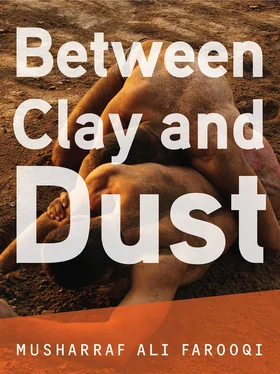The years of middle age had marked Ustad Ramzi’s constitution. His hair was turning grey at the temples, the skin was beginning to wrinkle, and the joints of his bones were slowly being drained of their long resilience to pain. But Ustad Ramzi’s devotion to his art remained unabated. Every morning before dawn he took the ewer from the niche in the wall and blessed the akhara clay by sprinkling it with blessed water. He then turned the clay in the pit, kneaded it with oil and herbs, and smoothed it before the trainees gathered to wrestle there. The modest tasks of turning and smoothing the akhara clay were as much a reminder for him of his pahalwan’s pledge as they were an exercise in humility.
In recent years, at the approach of winter Ustad Ramzi felt the penetrating, dull throb of rheumatic pain that stiffened his knee joints and strained his walk. It sometimes kept him awake at night. His body had finally revolted against the prolonged use of arsenic, which he took to help digest a pahalwan’s heavy diet. The year before, as winter progressed, the sharp pangs of pain he felt in his knees had gradually worsened, and made it difficult for him to finish his daily tasks in the akhara. In turning the clay, he still plied the mattock with a steady hand, and his back remained straight as a wood plank, but his knees could not hold up under stress in the same way. He did not tell anyone about his deteriorating health and carried on with his duties as before.
Ustad Ramzi’s pride would not allow him to ask another to take on his duties. When he was a trainee pahalwan, even to have the privilege to ask for an important task one had to first prove oneself worthy of it. He was willing to be persuaded to delegate the tasks, but Tamami never asked to take them on. He merely expressed surprise at Ustad Ramzi’s insistence on performing them himself when he could easily assign the work to one of the trainees.
Ustad Ramzi was disappointed by his brother’s disregard of what his elders held a sacred ritual of their creed. He told himself that if Tamami failed to realize the importance and purpose of those humble rituals, he could never understand the essence of his creed. At the same time, Ustad Ramzi also saw the futility of pointing this out to Tamami. He knew that his brother had to come to that understanding on his own: only then could he understand the true significance of his existence, and find the conviction to make sacrifices for his art. Until such time he could not be trusted with the responsibilities of guarding the clan’s interests to which Ustad Ramzi’s own life was dedicated.
In the past, Ustad Ramzi had refused to discuss the delegation of tasks to others, but winter was upon him once again, and his knee pain had resurfaced. Almost overnight he had to learn the limits beyond which he could not exert his body.
Ustad Ramzi had delayed announcing his retirement in the hope that a day would come when the clan would find worthy hands to defend its honor after him — a day when he could hand over his place to Tamami and finally hang up his fighter’s belt and retire. That day had not come.
Ustad Ramzi finally informed everyone in the clan that he would continue with his morning duty of blessing the akhara clay, and delegate to Tamami other duties such as the scheduling of trainees for preparing the akhara.
Tamami expressed happiness at his brother’s decision and failed to notice the bitterness in Ustad Ramzi’s smile.
Ustad Ramzi felt his vulnerability against the advance of disease and age keenly. He was still the titleholder and the head of his clan, but from the day he made the announcement he knew that he would begin to lose his grip on the akhara affairs which he had run unchallenged for many years.
Early in his professional career, Ustad Ramzi had realized that the entanglements of married life would not let him devote himself fully to his art and its exacting discipline. He vowed to remain celibate to achieve perfection in his art and shut his mind to thoughts of women. He finally attained the rank of an ustad or master, and acquired such celebrity that the mere privilege of being his sparring partner conferred eminence on a pahalwan. Throughout this time Ramzi observed his vow of celibacy.
The news of his visiting Gohar Jan’s kotha in the courtesans’ enclave was therefore received with great interest.
Gohar Jan was an accomplished singer whose raga recitals were renowned. Once a celebrated beauty, she was known for her haughty airs and capricious treatment of her lovers. Like other prominent tawaifs of her time, she maintained her own kotha where trainee girls or nayikas received instruction in the arts of musical entertainment. Gohar Jan’s kotha in the inner city was the largest and most famed.
The young men frequented the kothas to learn the bearings of polite society, the older men to socialize, or rekindle the memories of their lost youth. Whenever one of them fell in love with a tawaif or a nayika, his affairs provided a spectacle and entertainment to the rest of them, until he was cured of his passion. Those who could not survive it did not return. A tawaif who fell in love had only two choices: she could either put an end to the association, or leave the kotha to pursue a life outside — if one was offered her. Implicit in the latter choice was the understanding that she would never be readmitted to the kotha if the promise of the new life failed her. There was a universe of failed unions, dreams, and abandoned hopes that started in the kothas and trailed off into the anonymity of the city’s dark alleys. It was said — with some justification — that only the fickle survived in the kothas, and only the pitiless prospered.
When people heard the news of Ustad Ramzi’s visits to Gohar Jan’s kotha, they thought that like scores of others, he, too, was lured by Gohar Jan’s physical charms. But there was another purpose to Ustad Ramzi’s kotha visits.
Ustad Ramzi had been taken by an old acquaintance one evening to listen to Gohar Jan’s mehfil of a raga recital at the kotha. That day, for the first time, he saw Gohar Jan as she entered with her nayikas and took her seat at the head of the ensemble of musicians. He saw her command her troupe quietly and imperiously, often with just a glance. That day, also for the first time, Ustad Ramzi felt the powerful meditative effect of music when Gohar Jan started a raga.
He had always struggled with a component of his discipline which stressed the need for meditation to focus physical strength. That chance visit to Gohar Jan’s kotha made Ustad Ramzi understand how music could quieten the aggressive humors of his soul. He later returned to Gohar Jan’s kotha and soon became one of the habitués of her mehfils.
Those who watched Ustad Ramzi for any signs of becoming infatuated with the tawaif were disappointed. At the end of the mehfil, he always left her kotha with others. Even after it was borne out that it was Ustad Ramzi’s fondness for music that occasioned his visits to the kotha, that fact was not accepted. People made all kinds of insinuations: that Ustad Ramzi’s endeavors outside the akhara did not meet with any success; that it is one thing to floor men, and another to contest the favors of a tawaif like Gohar Jan.
These comments inevitably reached Ustad Ramzi’s ears, too, but he never learned that some people attributed these insinuations to Gohar Jan herself. Those who knew the tawaif could readily believe that it would have provided endless entertainment to Gohar Jan to make a spectacle of someone as self-absorbed and sacrosanct as Ustad Ramzi. But whether Gohar Jan found the sombre Ustad Ramzi too dull and uninteresting a quarry, or some other consideration hindered her, for some reason the insinuations ended there, and the gossip also died out.
Читать дальше












